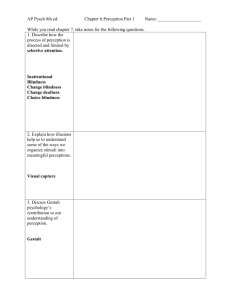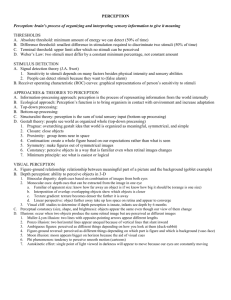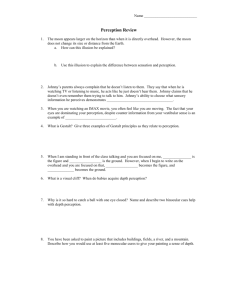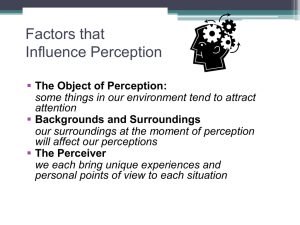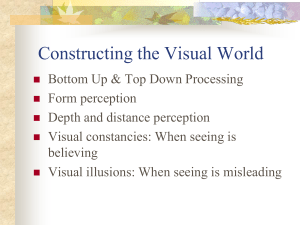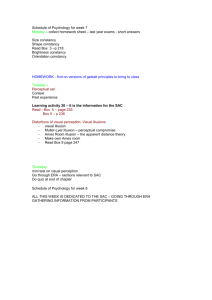Lecture topics: Lab - Illusion of depth:
advertisement
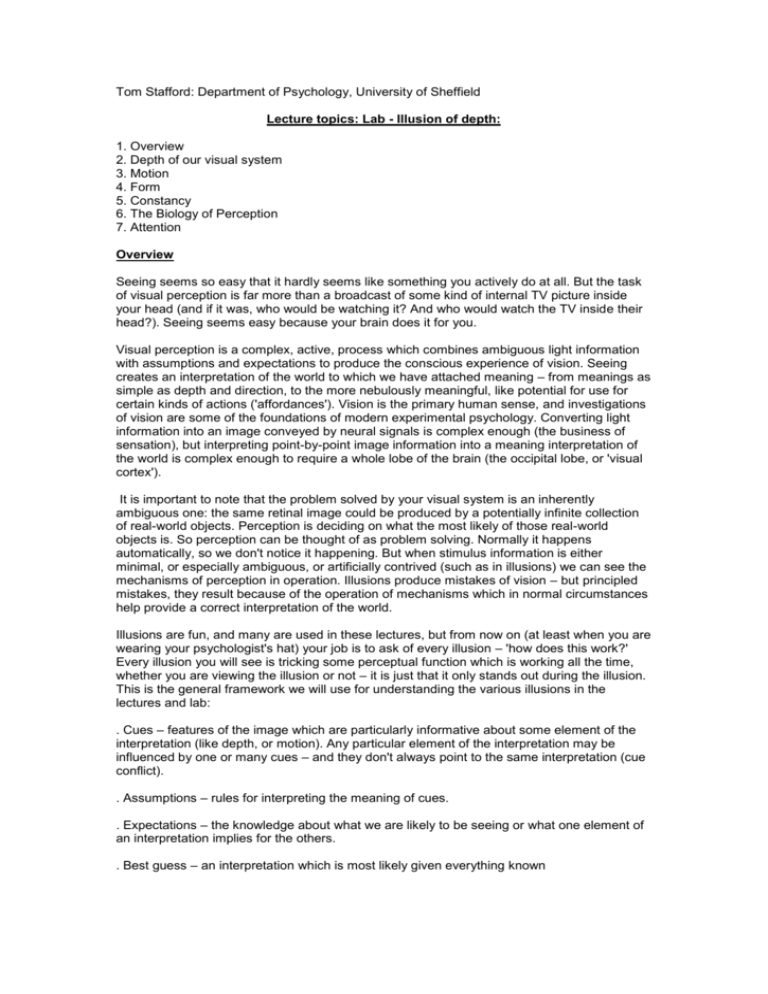
Tom Stafford: Department of Psychology, University of Sheffield
Lecture topics: Lab - Illusion of depth:
1. Overview
2. Depth of our visual system
3. Motion
4. Form
5. Constancy
6. The Biology of Perception
7. Attention
Overview
Seeing seems so easy that it hardly seems like something you actively do at all. But the task
of visual perception is far more than a broadcast of some kind of internal TV picture inside
your head (and if it was, who would be watching it? And who would watch the TV inside their
head?). Seeing seems easy because your brain does it for you.
Visual perception is a complex, active, process which combines ambiguous light information
with assumptions and expectations to produce the conscious experience of vision. Seeing
creates an interpretation of the world to which we have attached meaning – from meanings as
simple as depth and direction, to the more nebulously meaningful, like potential for use for
certain kinds of actions ('affordances'). Vision is the primary human sense, and investigations
of vision are some of the foundations of modern experimental psychology. Converting light
information into an image conveyed by neural signals is complex enough (the business of
sensation), but interpreting point-by-point image information into a meaning interpretation of
the world is complex enough to require a whole lobe of the brain (the occipital lobe, or 'visual
cortex').
It is important to note that the problem solved by your visual system is an inherently
ambiguous one: the same retinal image could be produced by a potentially infinite collection
of real-world objects. Perception is deciding on what the most likely of those real-world
objects is. So perception can be thought of as problem solving. Normally it happens
automatically, so we don't notice it happening. But when stimulus information is either
minimal, or especially ambiguous, or artificially contrived (such as in illusions) we can see the
mechanisms of perception in operation. Illusions produce mistakes of vision – but principled
mistakes, they result because of the operation of mechanisms which in normal circumstances
help provide a correct interpretation of the world.
Illusions are fun, and many are used in these lectures, but from now on (at least when you are
wearing your psychologist's hat) your job is to ask of every illusion – 'how does this work?'
Every illusion you will see is tricking some perceptual function which is working all the time,
whether you are viewing the illusion or not – it is just that it only stands out during the illusion.
This is the general framework we will use for understanding the various illusions in the
lectures and lab:
. Cues – features of the image which are particularly informative about some element of the
interpretation (like depth, or motion). Any particular element of the interpretation may be
influenced by one or many cues – and they don't always point to the same interpretation (cue
conflict).
. Assumptions – rules for interpreting the meaning of cues.
. Expectations – the knowledge about what we are likely to be seeing or what one element of
an interpretation implies for the others.
. Best guess – an interpretation which is most likely given everything known
Different situations involve different contributions of cues, assumptions and expectations. By
thinking about each of these elements individually you can begin to think about how most
illusions are 'put together'.
We'll now look at how various elements are extracted from an image (depth, motion, form),
how adjustments are made to keep perceptions constant under variations in the image
arriving at the eyes, at the neurobiological basis of perception and at attention.
Depth
Perceiving how far away things are is one of the first obvious problems of vision. Your eyes
get a 2D array of information (light hitting the retina), but you would like to know the
structure of things in glorious 3D. The various clues which the visual system uses for figuring
this out are know as 'depth cues'.
Binocular depth cues involve comparing the images in both eyes (binocular = two eyes).
Monocular depth cues can work with the
information available to just one eye. Depth perception is a good example of something which
can be calculated by our visual system in multiple ways – the lab class involves illusions
which play off one depth cue against another, resulting in a fooled perception of depth.
Understanding how the illusions work gives insight into the various depth cues we use and
how they combine.
Motion
Movement is a fundamental element of our perceptions – it is computed early and directly and
doesn't require our direct attention (in fact it attracts it). It is logically conceivable that our
brains could figure out how things are moving just by comparing where they are at different
points in time (i.e. By computing change in location over time). The motion after-effect
demonstrates that this is not the case. An after-effect is a bias towards perceiving the
opposite of what you have just been exposed to. After-effects are a consequence of
adaptation. The motion-after effect is when you go from viewing a continuously moving
stimulus to viewing a stationary one, it will appear to drift slightly in the opposite direction.
Note these things:
. The mere existence of a powerful after-effect strongly suggests that there exists specialised
neural processing for motion (confirmed by neuroscience).
. You can perceive something is moving, while at the same time also perceiving that it is in
the same place from moment to moment (perception of motion and location
are independent!).
. If you adapt only one eye, the after-effect will transfer to the other (suggesting that motion
perception is computed centrally in cortex, something confirm by neuroimaging).
. If you close your eyes the after-effect is 'stored', lasting nearly as long as it does immediately
(suggesting that the after-effect is the consequence of a purposeful adaptation to the
information coming in, not a side-effect of neural fatigue).
Form
Perceiving form is the problem of grouping things together correctly. A first fundamental step
is distinguishing what is an object and what is background (so called 'figure-ground'
perception). Then parts of the figure can be grouped according to gestalt principles. 'Gestalt'
translates roughly as 'good form', or 'meaningful whole'. The gestalt grouping principles are
examples of our vision using the principle of maximum likelihood to make
sense of ambiguous information. The examples of form perception demonstrate strongly how
image information become quickly imbued with meaning – the interpretation we place on the
image fundamentally affects how we see it; we cannot 'see' the image directly without an
interpretation. This interpretation is the product of 'top-down' influences (prior knowledge
about the stimulus, expectations) and 'bottom-up' influences (information which is in the
stimulus alone). A situation where the effect of top-down influences is particularly striking is
that where knowing what an image is instantly and irrevocably changes what you see it as
('one shot' learning). More subtle are the many examples of 'cultivated perception' that exist in
the appreciation of forms of art, or indeed any visual information which can be interpreted with
an 'expert eye'.
Constancy
Perceptual constancy is the phenomenon whereby two different images are seen as the same
because our visual system assumes they are generated by the same stimulus object. The
need for constancy mechanisms in perception arises because differences in lighting, rotation
and distance (and many other factors) will affect the image an object projects on the retina.
Illusions of constancy often highlight constancy mechanisms by making two identical things
look different according to context.
The Biology of Perception
Our conscious experience of vision is the product of the visual cortex, at the back of the brain.
Information arrives here from the eyes at 'primary visual cortex' and is routed through a
complicated, tangled, hierarchy of processing modules. One characterisation of cortical visual
processing is into 'what' and 'where' streams: the 'what' stream, which travels a ventral path to
the inferior temporal lobe – and a series of modules which are responsible for processing
motion and location information ; a 'where' stream, which travels a dorsal path to the superior
parietal lobe.
This functional organisation is reflected in the 'stepping feet' illusion of Stuart Anstis. The two
coloured blocks appear to stop as they cross the columns, especially in your peripheral vision.
This is because, without the colour information the blocks cannot be seen to move against the
columns. Your 'where' stream is insensitive to colour and so cannot provide the correct
motion information (you can see the effect of losing colour).
In addition to our cortical visual processing of the 'what' and 'where' streams, there is some
limited visual processing done subcortically by an area called the 'superior colliculus'. This
region is sensitive only to sudden changes in contrast (e.g. A light going
on or off) and changes in motion. Events such as these are registered by the superior
colliculus even when we are looking elsewhere, and tend to attract our attention. This is why
the best way to be noticed in a crowd is to wave.
Attention
The psychology of attention is a massive area of research. It is sufficient to note here that
attention acts as a series of filters on information coming in. These filters can be overcome by
things we are looking out for, things which are particularly intense (e.g. very loud music),
over-learnt (such as our names, if overheard in the background) or biologically relevant (e.g.
Motion). Our active attention represents one, dynamic, form of 'top-down' influence
on perception. It is also another way in which our perception of the world is not simply
mechanistic and stimulus-bound but truly a part of the wider operations of our cognition.

